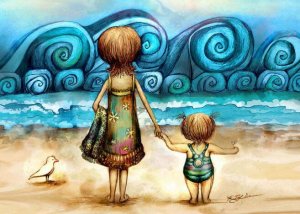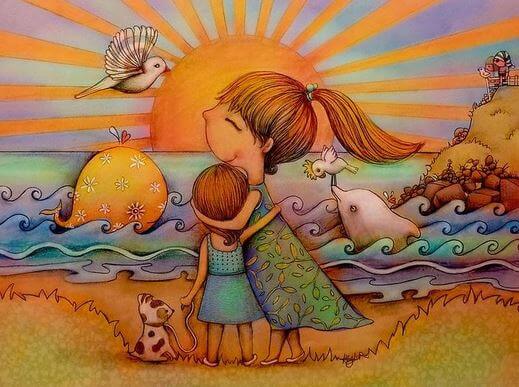Two Alternative Teaching Methods: Waldorf and Montessori

If anything characterizes the Waldorf and Montessori teaching methods it is that each one of them rejects formal education as we know it. That is, both these methods provide alternatives to rigid educational standards and practices.
To understand each method, we must consider their history and developmental contexts. Today we will lay out the principles of each, as well as a brief outline of their evolutionary development.
Regardless of their differences, each style has the clear objective of improving education and, therefore, social and human development. On this basis, let’s look a little more closely at these two teaching methods:

Waldorf education
This school founded in 1919 by the philosopher Rudolf Steiner,the director of the Waldorf Astoria cigarette factory, which was interested in excellence in the education of its employees. He maintained that youth education unfolds in three stages of 7 years each, and crafted the educational model accordingly:
- From 0-7 years. In this first stage, it is understood that learning is based on imitation and based heavily in very sensory approaches. Kneading bread, grinding beans, painting with watercolors, making crafts etc.
- From 7 to 14 years. In this second stage, the imagination is strengthened through different activities: carving, didactic games, textiles, music, swimming, athletics, etc.
- From 14 to 21 years. This phase is characterized by the search for reality and truth. Independent thinking and the search for the essential is encouraged through activities such as sewing with a machine, knitting, metal crafts, basketry, restoration, cinematic art, electricity, etc.
The Waldorf method emphasizes the spiritual aspects of educational development and encourages each student to develop his or her artistic expression in a complex and holistic manner. It is intended to encompass the growth of the individual in conjunction with each of its strengths.
There are Waldorf schools all over the world and, as a curiosity, celebrities like Jennifer Aniston and Sandra Bullock have studied in their schools.
One of the criticisms of the Waldorf philosophy is that it is not grounded in empirical evidence or research.

The Montessori pedagogy, educating children with joy
The Montessori pedagogy is currently one of the most widespread in education. Between the nineteenth and early twentieth centuries, Italian educator, Maria Montessori, developed a pedagogical method based on the idea that a child must develop his skills freely.
In other words, the adult will not be the one to direct the activity of the child, but rather the child should adapt his environment to this level of development and learning interests. Thus, the method suggests an open development in a holistically structured environment.
Specialized learning materials help students discover concepts and learn about their world. There are certain sensitive periods, moments of great potential for neuro-emotional evolution, where education is paramount. Specifically, it is essential that in the period from 0 to 11 years children to explore their world as independently as possible.

Montessori schools are characterized by the microcosms or microworlds within them. This is the creation of a purely child-like environment: child-size furniture, toys that promote exploration and cognitive flexibility, etc.
The attention of parents is essential to Montessori education. They must participate actively in the learning process of their children and demonstrate affection and respect for the individual rhythms of their child.
However, rather than a pedagogical method, when we talk about Montessori we refer to an educational model that encompasses all learning and is based in concrete proposals.
If anything characterizes the Waldorf and Montessori teaching methods it is that each one of them rejects formal education as we know it. That is, both these methods provide alternatives to rigid educational standards and practices.
To understand each method, we must consider their history and developmental contexts. Today we will lay out the principles of each, as well as a brief outline of their evolutionary development.
Regardless of their differences, each style has the clear objective of improving education and, therefore, social and human development. On this basis, let’s look a little more closely at these two teaching methods:

Waldorf education
This school founded in 1919 by the philosopher Rudolf Steiner,the director of the Waldorf Astoria cigarette factory, which was interested in excellence in the education of its employees. He maintained that youth education unfolds in three stages of 7 years each, and crafted the educational model accordingly:
- From 0-7 years. In this first stage, it is understood that learning is based on imitation and based heavily in very sensory approaches. Kneading bread, grinding beans, painting with watercolors, making crafts etc.
- From 7 to 14 years. In this second stage, the imagination is strengthened through different activities: carving, didactic games, textiles, music, swimming, athletics, etc.
- From 14 to 21 years. This phase is characterized by the search for reality and truth. Independent thinking and the search for the essential is encouraged through activities such as sewing with a machine, knitting, metal crafts, basketry, restoration, cinematic art, electricity, etc.
The Waldorf method emphasizes the spiritual aspects of educational development and encourages each student to develop his or her artistic expression in a complex and holistic manner. It is intended to encompass the growth of the individual in conjunction with each of its strengths.
There are Waldorf schools all over the world and, as a curiosity, celebrities like Jennifer Aniston and Sandra Bullock have studied in their schools.
One of the criticisms of the Waldorf philosophy is that it is not grounded in empirical evidence or research.

The Montessori pedagogy, educating children with joy
The Montessori pedagogy is currently one of the most widespread in education. Between the nineteenth and early twentieth centuries, Italian educator, Maria Montessori, developed a pedagogical method based on the idea that a child must develop his skills freely.
In other words, the adult will not be the one to direct the activity of the child, but rather the child should adapt his environment to this level of development and learning interests. Thus, the method suggests an open development in a holistically structured environment.
Specialized learning materials help students discover concepts and learn about their world. There are certain sensitive periods, moments of great potential for neuro-emotional evolution, where education is paramount. Specifically, it is essential that in the period from 0 to 11 years children to explore their world as independently as possible.

Montessori schools are characterized by the microcosms or microworlds within them. This is the creation of a purely child-like environment: child-size furniture, toys that promote exploration and cognitive flexibility, etc.
The attention of parents is essential to Montessori education. They must participate actively in the learning process of their children and demonstrate affection and respect for the individual rhythms of their child.
However, rather than a pedagogical method, when we talk about Montessori we refer to an educational model that encompasses all learning and is based in concrete proposals.
This text is provided for informational purposes only and does not replace consultation with a professional. If in doubt, consult your specialist.







